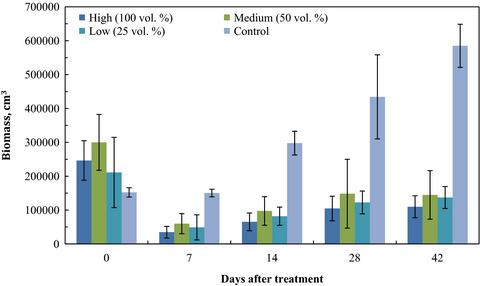当前位置:
X-MOL 学术
›
Food Energy Secur.
›
论文详情
Our official English website, www.x-mol.net, welcomes your
feedback! (Note: you will need to create a separate account there.)
Herbicidal effects of wood vinegar on nitrophilous plant communities
Food and Energy Security ( IF 4.0 ) Pub Date : 2020-10-12 , DOI: 10.1002/fes3.253 Juan Luis Aguirre 1, 2 , Juan Baena 1, 2 , María Teresa Martín 1, 2 , Sergio González 1, 2 , José Luis Manjón 3 , Manuel Peinado 2, 4
Food and Energy Security ( IF 4.0 ) Pub Date : 2020-10-12 , DOI: 10.1002/fes3.253 Juan Luis Aguirre 1, 2 , Juan Baena 1, 2 , María Teresa Martín 1, 2 , Sergio González 1, 2 , José Luis Manjón 3 , Manuel Peinado 2, 4
Affiliation

|
In Europe, and many parts of the world, the number and variety of animal species on farmland is in marked decline. There is a need to search for alternatives that are safe for the environmental and are effective in controlling weeds. Wood vinegar from biomass pyrolysis may be an alternative for herb control. In this study, Wood vinegar (WV) pH, moisture content, and composition were analyzed, with subsequent assessment of the effects of WV on nitrophilous plant communities under natural conditions. The following three treatments were used: WV dissolved in water to form 25 vol% and 50 vol% dilutions and undiluted WV (100 vol%). The results showed a greater than 70% decrease in biomass at 7 days after WV application in all treatments. At the end of the sampling period (day 42), the plots treated with WV had four‐times less biomass than the controls. No significant differences were observed among different treatments, thus indicating that a 25% dilution may suffice for use as an herbicide. However, this concentration also produced the highest variability in results. The area cleared by the affected species was colonized by perennial species. At the end of the sampling, 80% of the area of the treated plots was occupied by perennial species, whereas this percentage was 30% in control plots. Electron micrographs showed that the epidermis of the treated plants was severely affected within a few hours of the treatment, particularly of the stomatal cells. The most affected species were those with smooth leaves without protective structures and those with lighter stems and leaves. The good herbicidal performance of WV notwithstanding, regulations must be clarified for its use as an herbicide.
中文翻译:

木醋对硝基植物群落的除草作用
在欧洲和世界许多地方,农田上动物物种的数量和种类正在显着下降。需要寻找对环境安全且能有效控制杂草的替代品。来自生物质热解的木醋可能是控制草本植物的替代方案。在这项研究中,分析了木醋 (WV) 的 pH 值、水分含量和成分,随后评估了 WV 在自然条件下对硝基植物群落的影响。使用以下三种处理:将WV溶解在水中以形成25体积%和50体积%稀释液以及未稀释的WV(100体积%)。结果显示,在所有处理中施用 WV 后 7 天,生物量减少了 70% 以上。在采样期结束时(第 42 天),用 WV 处理的地块的生物量比对照组少四倍。不同处理之间没有观察到显着差异,因此表明 25% 的稀释度可能足以用作除草剂。然而,该浓度也产生了最大的结果变异性。受影响物种清理的区域被多年生物种占据。采样结束时,处理地块的 80% 面积被多年生物种占据,而对照地块的这一比例为 30%。电子显微照片显示,经过处理的植物的表皮在处理后的几个小时内受到严重影响,特别是气孔细胞。受影响最严重的物种是那些叶子光滑、没有保护结构的物种以及茎和叶颜色较浅的物种。尽管 WV 具有良好的除草性能,但必须明确其作为除草剂的使用规定。
更新日期:2020-11-16
中文翻译:

木醋对硝基植物群落的除草作用
在欧洲和世界许多地方,农田上动物物种的数量和种类正在显着下降。需要寻找对环境安全且能有效控制杂草的替代品。来自生物质热解的木醋可能是控制草本植物的替代方案。在这项研究中,分析了木醋 (WV) 的 pH 值、水分含量和成分,随后评估了 WV 在自然条件下对硝基植物群落的影响。使用以下三种处理:将WV溶解在水中以形成25体积%和50体积%稀释液以及未稀释的WV(100体积%)。结果显示,在所有处理中施用 WV 后 7 天,生物量减少了 70% 以上。在采样期结束时(第 42 天),用 WV 处理的地块的生物量比对照组少四倍。不同处理之间没有观察到显着差异,因此表明 25% 的稀释度可能足以用作除草剂。然而,该浓度也产生了最大的结果变异性。受影响物种清理的区域被多年生物种占据。采样结束时,处理地块的 80% 面积被多年生物种占据,而对照地块的这一比例为 30%。电子显微照片显示,经过处理的植物的表皮在处理后的几个小时内受到严重影响,特别是气孔细胞。受影响最严重的物种是那些叶子光滑、没有保护结构的物种以及茎和叶颜色较浅的物种。尽管 WV 具有良好的除草性能,但必须明确其作为除草剂的使用规定。











































 京公网安备 11010802027423号
京公网安备 11010802027423号